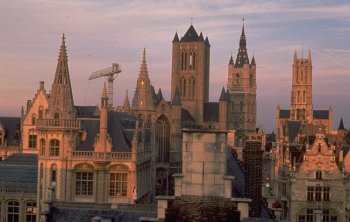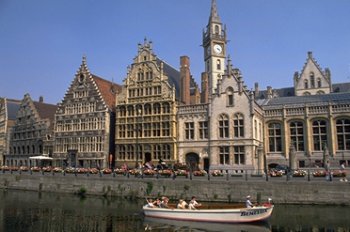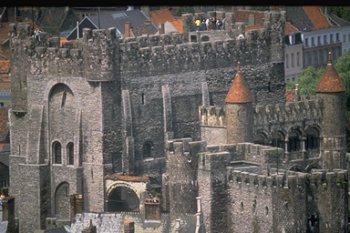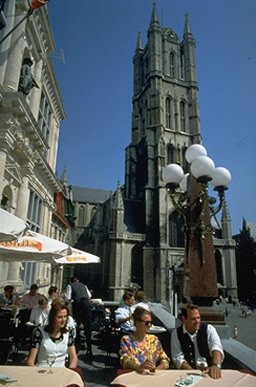|
|
| |
BELGIUM
GHENT
No other Flemish city has as many historic buildings as Gent. Anyone visiting the Arteveld city is embarking on a walk through the history of Europe. Furthermore, the city's central location at the confluence of the Scheldt and Lys is ideal for day-trips to Brugge, Antwerpen, Brussel, Tournai and Lille. All these cities are within less than one hour's drive.
Three towers
The skyline of Gent is dominated by three towers. The most impressive is that of Saint Bavo's Cathedral. This cathedral, with sections in Romanesque, Gothic and Baroque style, is well worth the visit for so many reasons. Charles V was baptised in this church in 1500. This is also home to the world-famous painting "The Adoration of the Mystic Lamb" by the Van Eyck brothers.
The second Gent tower belongs to a place of worship, the no less impressive Saint Nicholas' Church.

The Towers
Author: M. Hendryckx
Copyright © Toerisme Vlaanderen
The third tower is that of the Belfort, which forms a whole with the Lakenhalle (Clothmakers' Hall). The silhouette of the 95 metre high belfry is a proud symbol of the power of the mediaeval guilds. At 65 metres high, the uppermost gallery offers a unique view of the city.
City Hall
Opposite the Belfry, you will find the City Hall. With a late Gothic wing and a Renaissance wing, this building forms a remarkable synthesis of Gent's architectural history. In one of the impressive rooms, the Pacification of Gent was signed in 1576, and religious peace between Catholics and Protestants became reality.
Strolling beside the Lys
Nobody visiting Gent can resist the temptation to strol along the Graslei or the Korenlei. These are among the most elegant streets in Flanders. Historically important houses from the 12th to the 17th century are reflected in the water of the Lys. If you want to improve the view still further, you can admire it from a boat on the river. Nearby, sightseeing boat tours set off for trips around the city. A little further on, in the shadow of the Palace of Justice, you can also climb on board for a romantic boat trip on the Lys to Deurle or Sint-Martens-Latem. Mooring here will introduce you to the splendours of the Lys valley landscape, that has inspired so many generations of painters.

Graslei Street
Author: Michalski
Copyright © Toerisme Vlaanderen
Gravensteen
At the end of the Graslei, where the Lys and the Lieve merge, rises the imposing Gravensteen. This mediaeval water fort dates from the 12th century and was built by the Counts of Flanders. The fort has withstood the ravages of time, and now houses a historic museum devoted to the practices of mediaeval torture and the administration of justice. From the roof, you have a fine panorama over the city centre, in particular of the Patershol, a district where the mediaeval street pattern and housing have remained virtually intact.
 Gravensteen
Author: D. de Kievith
Copyright © Toerisme Vlaanderen
Museums
In the Patershol, you will find the unique Museum of Folk Art with 18 typical Flemish houses, which are a reminder of the life of the people of Gent in around 1900. Gent also has a wealth of museums. In the Citadel park are the Fine Arts Museum, with an outstanding collection of Flemish paintings from the Flemish Primitives to the Latem School, and the brand new SMAK, which in Dutch stands for Municipal Museum of Modern Art, run by maverick curator Jan Hoet. The Museum of Antiquity, with its wonderful collection of old utensils, weapons and clothing, is housed in the former Cistercian abbey of Bijloke. The mediaeval Saint Pieter's Abbey now houses the Centre for Art and Culture.
Shopping and having fun
Gent is a shopping paradise. The Arteveld city has an implausibly large number of shopping streets and lanes, from the Kouter to the Volderstraat, from the Veldstraat and the Brabantdam to the Langemunt and the Friday market...

Saint Bavo Place
Author: Gwapo
Copyright © Toerisme Vlaanderen
This large square in the middle of the city is surrounded by elegant old guild houses. This is where a great deal of public life used to be played out. On the Friday market place, with the statue of folk hero Jacob van Artevelde in the centre, you will find the beating heart of the Gentse Feesten. Click here for more info about other Gent events. For ten days around 21 July, the national holiday, the Gent city centre goes wild. Concerts, street theatre, parades, folk balls and banquets provide the material for a ten-day long Flemish fair. A must for any visitor.
Charles V
Gent was the birthplace of Emperor Charles V, exactly 500 years ago. Between September 1999 and June 2000, Gent will be commemorating its most famous "notorious" son in exhibitions and cultural events. During all those festivities, the love-hate relationship between the Arteveld city and the Emperor will come to the fore. It was Charles V who earned the people of Gent their nickname of "noose-wearers", because they had to beg the Emperor for forgiveness with a noose around their necks.
Information is Copyright © Toerisme Vlaanderen
| |
|
Festivals & Events
Jan Van Eyck and the Mediterranean World
24 March - June
The first exhibition dedicated to early Netherlandisch painting and its influence on the Southern European art scene of its days looks at works commissioned from Jan Van Eyck and other Flemish Primitives working abroad. Major works from all over Europe will be brought together in one of the finest museums in Bruges.

Brussel jubel park
Author: d. de Kievith
© Toerisme Vlaanderen
The Brueghel Enterprise
22. March - 23. June 2002
The exhibition will bring together about forty paintings by this artist who is well-known for having made an abundant number of copies after the works by his father Pieter Bruegel the Elder. The exhibition aims to juxtapose different versions of the same composition and to study and analyse them with state-of-the-art laboratory techniques.
It will be the first time ever that such an important number of versions is gathered. The exhibition is designed around four themes, each of them centred on a reference work: Census in Bethlehem, Winter Landscape with Bird Trap, The Adoration of the Magi in the Snow and The Farmer’s Advocate.

Brugge lace-maker
Author: d. de Kievith
© Toerisme Vlaanderen
Adriaan Brouwer Beer Festival
Yearly festival on the market square of the beautiful town of Oudenaarde.
Tel: (32-55) 31-7251

Brussel Grand Place
Author: d. de Kievith
© Toerisme Vlaanderen
Jazz Brugge 2002
August - 15-18
De Werf's European Jazz Festival is to be held alternating with the Middelheim festival, i.e. every second year.
Its venue will be the newly built, for the Brugge 2002 festivities, concert centre, a modern building with the largest stage in Belgium and capacity of 1400 seats.
Its emphasis will be on European jazz and artists.
There will be 3 to 4 groups per day, concerts starting around 15h and ending at 23h.

Brugge scenic view
Author: d. de. Kievith
© Toerisme Vlaanderen
Diamon Museum - Antwerp
Where the entire process of diamond mining and processing can be viewed.. Antwerp is the very centre of the world's diamond industry. More than 70% of the world's diamonds are cut, polished and traded here.

Brussel procession
Author: A. Koprianov
© Toerisme Vlaanderen
The Royal Greenhouses
April 19 - May 5
The Royal Greenhouses in Laeken cover six acres of neo-classical rotundas, domes and galleries. Twenty full time gardeners tend the giant ferns, fruit-bearing banana trees, grottoes, glades and grassy vistas. Highlights include the Azalea House, the rotunda, a colony of birds and the orange trees. Walkways are filled with climbing geraniums and fuschias, whose blossoms form an overhead canopy. The visit ends with a short walk through the Royal Park.

Brussel Grand'Place flowers
Author: J. J. Soenen
© Toerisme Vlaanderen
The Abbey of Villers-la-Ville
The Cistercian Abbey dates back to the 12th century. In the 19th century, a large number of artists, painters and writers, such as Victor Hugo, were attracted by the beauty of the majestic ruins, which are still sometimes used as a dramatic setting for French drama and classical concerts.

Oostende Mercator
Author: d. de Kievith
© Toerisme Vlaanderen
|
|
|